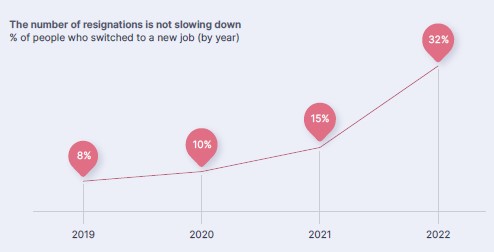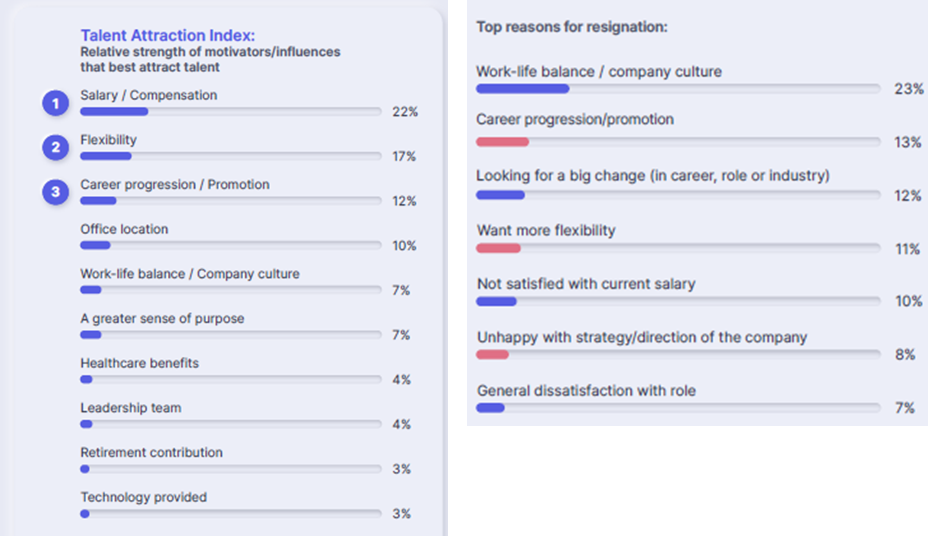This week, I attentively reviewed Michael Page’s latest “Talent Trends” report, entitled “The Invisible Revolution”. According to the recruitment firm, which surveyed nearly 70,000 individuals globally, spanning diverse ages, sectors, and levels of responsibility, we are in the midst of witnessing the most profound workplace cultural shift “since the advent of the Internet”. Phenomena like the Great Resignation and Quiet Quitting, which emerged in the wake of the COVID pandemic, are not sparing any sector or region.
Indeed, the initial interpretation of the survey results is somewhat alarming for employers. Upon reviewing the European version of the report, comprising over 28,000 responses, I was especially struck by several statistics:
- 88% of employees report being “open to new opportunities”, with 52% seeking to progress either immediately or within the forthcoming 6 months;
- This percentage experiences only minor variations across countries (from 73% in Belgium to… 97% in Portugal!), age brackets, genders, levels of responsibility, and sectors;
- Employer loyalty seems to have evaporated: 80% of those who commenced new roles in the preceding 12 months are already exploring new opportunities;
- The materialization of such intentions continues. Contrary to many companies’ belief that the Great Resignation had subsided in 2022, the report indicates otherwise, with 32% of respondents having transitioned to new roles in 2022.

- The report culminates by highlighting a paradox: although employees appear more willing than ever to transition between companies, a slim majority seem rather content with their work, compensation, and working conditions.
For the authors of the report, the conclusion is unequivocal: the balance of power presently favors the employees, who are capitalizing on a historically low unemployment rate, and their manifested satisfaction doesn’t mitigate their propensity for change. Consequently, employers must brace themselves for a new epoch characterized by heightened staff turnover and fortify their strategies for identifying and attracting new talents through appealing packages and compelling employer brand propositions – not surprising given the fact that Michael Page is first and foremost a… recruitment agency.
However, I perceive things differently. Initially, I would moderate the authors’ alarmism by observing that even at the peak of the Great Resignation, departure intentions far from universally culminate in actual transitions: from 85% of employees aspiring to change roles within 6 months to 32% actualizing such transitions within a year. Moreover, as I have articulated on numerous occasions, I believe the leverage that employees currently enjoy in their “power” dynamic with employers is predominantly situational and is likely to achieve equilibrium over time—the recent economic deceleration is beginning to furnish early indications of this equilibrium.
Revisiting the report, it’s plausible to construct an alternative “narrative” utilizing the extensive quantitative data provided. I simply juxtaposed the list of most pivotal factors for attracting new talents to that of the causes of resignation. The asymmetry between these two rankings is notable: salary is the prime attractor of talents (see left-hand side below) but ranks only fifth as a resignation trigger (right-hand side). The converse holds true for work/life balance.

In my view, this seeming paradox reflects both a fervent desire among employees for organizational commitment and a profound disillusionment with their current circumstances. Indeed, reverting to the higher echelons of the left-hand ranking, an employee is not solely attracted by superior remuneration, but also by enhanced working condition flexibility—a stark contrast to “work/life balance”—and advancement opportunities.
To summarize: employees are poised to intensify their commitments ubiquitously, provided the right opportunities are availed. Evidently, within their current organizations, such opportunities either do not exist or are perceived to be non-existent, with 39% of the surveyed indicating no salary increment over the past two years. Consequently, in the absence of progressive prospects, the primary aspiration gravitates towards sustaining their life’s comfort, elucidating why “work/life balance” leads the right-hand ranking—a mentality that aptly characterizes Quiet Quitting…
Finally, delving into potential solutions, I don’t contest the report authors’ recommendations. In the short to medium term, corporations will need to underscore their competitive edges to retain a voice in the “talent war”. Nonetheless, I postulate that ‘brain drain’ is not predestined and that various mechanisms are available to companies to retain their workforce.
- With a global resurgence of inflation, the issue of remuneration returns to the spotlight. Certain employees might perceive a decline in their living standards if their wages do not keep pace with the escalating cost of living (one in two employees express this sentiment as per the report), potentially compounded by a sense of inequity if the newly onboarded enjoy a salary structure doubly revised by inflation and the dearth of proficient candidates. Hence, it is imperatively beneficial for employers to allocate time and resources in their internal processes for salary review and to actualize them at a minimum annually, if not more frequently, contingent upon the economic reality and the employment market dynamics.
- As it is pivotal to sustain a pipeline of external candidates, it is equally vital to strategize for internal succession. I have previously delineated the demographic hazards overshadowing numerous developed economies. In anticipation of the multitude of impending retirements, employers must commence the formulation of strategies to cultivate the forthcoming leaders and to meticulously delineate their career trajectories. This initiative, being salvational for the enterprise, will concurrently unfold novel opportunities for the most adept collaborators.
- Indeed, the transition of collaborators should be assessed not solely on quantitative grounds but on qualitative ones as well. The organizational loss is substantial when a ‘top talent’ exits, and conversely, the departure of a neutral or potentially detrimental entity might nearly be perceived as advantageous. Discerning the pivotal value additions crucial for the organizational framework, particularly in an environment of swift talent mobility, through rigorous performance management mechanisms, is undeniably pertinent here.
In conclusion, as we navigate through the transformative landscape of employee retention and recruitment in this era marked by an “Invisible Revolution,” a meticulous reevaluation of organizational strategies is imperative. The criticality of aligning remuneration with the living standards, fostering an environment conducive to both professional growth and satisfactory work-life balance, and maintaining a harmonious synergy between attracting external talents and nurturing internal potentials cannot be understated. The dynamic interplay between qualitative and quantitative aspects of employee turnover necessitates robust, proactive approaches, facilitating the retention of invaluable talents and fostering an environment of equitable satisfaction and mutual growth. The enterprise of tomorrow must be adeptly equipped with strategies that are not only salutary to the organizational structure but also conducive to the multifaceted aspirations of the modern workforce, balancing the scales of employee satisfaction and organizational objectives in this ever-evolving professional ecosystem.
